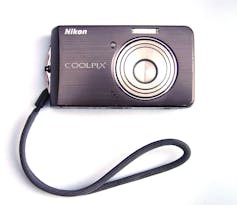Why are so many Gen Z-ers drawn to old digital cameras?
Smartphone cameras tend to be more advanced than their clunky, point-and-shoot predecessors. But the allure of cameras from the early 2000s reflects a broader search for meaning.

The latest digital cameras boast ever-higher resolutions, better performance in low light, smart focusing and shake reduction – and they’re built right into your smartphone.
Even so, some Gen Z-ers are now opting for point-and-shoot digital cameras from the early 2000s, before many of them were born.
It’s something of a renaissance, and not just for older cameras. The digital camera industry as a whole is seeing a resurgence. Previously, industry revenue peaked in 2010 and was shrinking annually through 2021. Then it saw new growth in 2022, and it is projected to continue growing for the coming years.
But why?
One explanation is nostalgia, or a yearning for the past. And indeed, nostalgia can be an effective coping strategy in times of change and upheaval – the COVID-19 pandemic is just one of the disorienting shifts of the past few decades.
But my research on people’s experiences with technology, which includes photography, suggests a deeper explanation: seeking meaning.
It’s not that these Gen Z-ers are longing to return to childhood, but that they are finding and expressing their values through their technological choices. And there’s a lesson here for everyone.
The human need for meaning
Humans have many needs – food, shelter, sex and so on. But humans also feel the urge to find meaning in life.
Meaning is different from happiness. Though happiness and meaning are often correlated, meaning doesn’t necessarily include the pleasure that characterizes happiness. Meaningful pursuits may involve struggle, suffering or even sacrifice. Meaning also lasts longer, whereas happiness is fleeting.
What does meaning do for people?
At its core, meaning is about identifying one’s values and making choices to develop oneself as a person. It allows a person to engage with the various aspects of their personality – “the multitudes” contained therein, as Walt Whitman wrote.
Put differently, meaning is about weaving a personal narrative from the facts of life. And it really is a need, not just something that’s nice to have. Meaning is what makes life feel valuable and worth living.
Seeking meaning with technology
Why do people adopt one technology over another? According to what scholars call the technology acceptance model, people consider two major aspects when choosing a technology: its perceived usefulness and its perceived ease of use.
But certainly there are other considerations, especially for personal technologies. People choose some technologies for the way they contribute to meaning. And the search for meaning extends beyond choosing a technology to the way a person uses and experiences it. For example, many people use social media in constructing their sense of self.
In my own research, I discerned four themes involved in people’s meaningful experiences with technology:
- Presence: People choose formats and technologies that will help them be more present and attentive during the experience.
- Centripetal force: A person’s relationship with the technology begins with a central practice but gradually expands to become a bigger part of their life. For example, as a person’s photography practice becomes more meaningful, they may find themselves printing photos, curating their collection and shopping for more equipment.
- Curiosity: A sense of wonder and interest guides the experience.
- Self-construction: Meaningful experiences with technology contribute to the person’s sense of self.
In my research on ultra-distance runners, who run races even longer than marathons, I saw all these elements at play. Runners chose particular shoes, GPS watches, sensors and software – or avoided them – in part to be more present with their bodies.
This can make the running itself more meaningful, along with other activities such as writing race recaps, keeping a training log and sharing photos.

Over time, running becomes a central part of a person’s identity – they become “a runner.” In the end, long-distance running is not always enjoyable, but it is definitely meaningful.
And so technology, whether it’s the kind associated with running or some other activity, becomes a key way people can discern their values and make choices that support and better embody those values.
The meaning within old digital cameras
In this context, using a standalone digital camera immediately enhances the meaningfulness of an experience. Meaning is about exercising choice, and nowadays most people don’t own a camera at all – they just use their smartphone.
Digital cameras also enable presence: You need to remember to carry the camera around, and in return it won’t give you notifications or show you other apps while you’re shooting.

That goes for any standalone camera. But old cameras, in particular, have a set of qualities that help users make meaning.
First, the image quality is poorer. But on social media, photos that get posted are less about polish and precision and more about sharing experiences and telling stories. As social media theorist Nathan Jurgenson writes in his book “The Social Photo,” “As a medium, social photography becomes an important means to experience something not representable as an image but instead as a social process: an appreciation of impermanence for its own sake.”
As a person chooses which photos to share and how to edit them, they are expressing their values and developing their sense of self. To some extent, smartphone photo filters allow for some of this expression, but old digital cameras produce different kinds of visual effects and lack the automated features designed to professionalize the look of each image.
Older cameras also introduce challenges in getting the images onto social media. They require cables, software and multiple steps to transfer the images. It’s a far cry from one-click image generation with artificial intelligence. What this means is that photography involves many more activities beyond simply taking photos. Photography becomes a bigger part of one’s life.
All this friction increases a person’s involvement in the process, inviting choices along the way. This is precisely the thinking behind the slow technology movement, which aims to design technology for goals like self-reflection, rather than efficiency or productivity. Research on meaningful design shows people form stronger attachments to products when they have to make more choices or get more involved.
When it comes to finding meaning in older forms of photography – whether you use a digital camera or a film camera – the slower process of creating and sharing images outweighs the speed, efficiency and crisp imagery of smartphone cameras.
Crafting a more meaningful life
The meaning hidden within old digital cameras contains broader lessons.
In recent years, critics have bemoaned the rupturing of social institutions and the transformation of digital platforms into places that merely serve as vehicles to sell ads and collect data from users. During the pandemic, life itself threatened to go digital with all the hype surrounding the metaverse.
I believe that a key to living well in the near future is to identify where you can create choices, so you don’t feel like you’re drifting along at the mercy of algorithms and the whims of Big Tech.
Perhaps you could start a chapter of the Luddite Club – as a group of teens in Brooklyn recently did – and play board games in the park on weekends. Perhaps you could opt for a paper book rather than a podcast, specifically because you can’t do something else while you’re reading it.
On the surface, deliberately rejecting the latest, flashiest forms of technology may seem like a problem – “You’ll be left behind and miss out!”
But on the other hand, slowing down life by engaging with slower technology creates space to make choices more thoughtfully in relation to your values – and cultivate more meaningful involvement in your own life.
Tim Gorichanaz does not work for, consult, own shares in or receive funding from any company or organization that would benefit from this article, and has disclosed no relevant affiliations beyond their academic appointment.
Read These Next
As DOJ begins to release Epstein files, his many victims deserve more attention than the powerful me
Powerful men connected to Jeffrey Epstein are named, dissected and speculated about. The survivors,…
The world risks forgetting one of humanity’s greatest triumphs as polio nears global eradication − 7
Polio may finally be defeated in the next 5 years. Will the world recognize what an extraordinary achievement…
People are getting their news from AI – and it’s altering their views
Even when information is factually accurate, how it’s presented can introduce subtle biases. As large…






